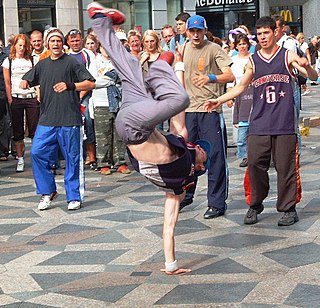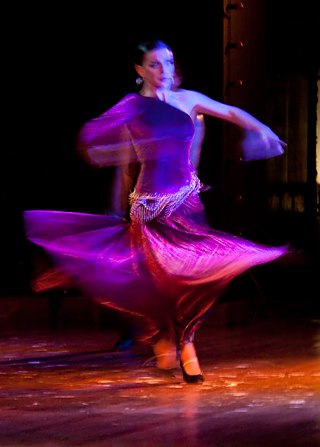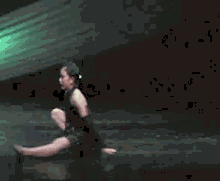
Calisthenics or callisthenics (/ˌkælɪsˈθɛnɪks/) is a form of strength training that utilizes an individual's body weight as resistance to perform multi-joint, compound movements with little or no equipment.

Contortion is a performance art in which performers called contortionists showcase their skills of extreme physical flexibility. Contortion acts often accompany acrobatics, circus acts, street performers and other live performing arts. Contortion acts are typically performed in front of a live audience. An act will showcase one or more artists performing a choreographed set of moves or poses, often to music, which require extreme flexibility. The physical flexibility required to perform such acts greatly exceeds that of the general population. It is the dramatic feats of seemingly inhuman flexibility that captivate audiences.
Because ballet became formalized in France, a significant part of ballet terminology is in the French language.
Strikes can be offensive moves in professional wrestling, that can sometimes be used to set up an opponent for a hold or for a throw. There are a wide variety of strikes in pro wrestling, and many are known by several different names. Professional wrestlers frequently give their finishers new names. Occasionally, these names become popular and are used regardless of the wrestler performing the technique.

The bridge is an exercise. Many variations of this exercise are employed throughout the world, most commonly the balancing of the body on the hands and the feet. It is intended to improve lower back and gluteus strength. Examples of bridging in sportive or self-defense applications are seen in Kung Fu, Judo, Brazilian jiu jitsu, Capoeira, mixed martial arts, and wrestling.

An aerial cartwheel or side aerial is an acrobatic move in which a cartwheel is executed without touching hands to the floor. During the execution of a standard cartwheel, the performer's body is supported by the hands while transitioning through the inverted orientation whereas an aerial cartwheel, performer is airborne while inverted. To compensate for lack of support from the hands, leg momentum is employed to keep the performer airborne until the leading foot touches down. Aerial cartwheels can be executed while running or from a stationary, standing position. The front leg lunges and the back leg drives back creating momentum. Aerial cartwheels are also known by various other names, including side flip, side somersault, air cartwheel, no-hands cartwheels, or simply aerials.

A cartwheel is a sideways rotary movement of the body. It is performed by bringing the hands to the floor one at a time while the body inverts. The legs travel over the body trunk while one or both hands are on the floor, and then the feet return to the floor one at a time, ending with the athlete standing upright. It is performed in a variety of athletic activities, including performance dance and some types of Indian dance, in gymnastics and cheer, and in the martial arts of capoeira. It is called a cartwheel because the performer's arms and legs move in a fashion similar to the spokes of a turning (cart) wheel. In classical Indian Karana dance, it is called talavilasitam, and in capoeira is called aú. Its first use has been recorded in 1925 by Matthew Douglass, the leader of a popular circus based in Gosforth, Newcastle, who used the trick when dodging flaming spears.

A handspring is an acrobatic move in which a person executes a complete revolution of the body by lunging headfirst from an upright position into an inverted vertical position and then pushing off from the floor with the hands so as to leap back to an upright position. The direction of body rotation in a handspring may be either forward or backward, and either kind may be performed from a stationary standing position or while in motion. Body movement may be terminated upon completion of a handspring, or the performer's momentum may be leveraged so as to immediately perform another handspring or other rotational move.

The flare is an acrobatic move in which the performer alternates balancing the torso between either arm while swinging the legs beneath in continuous circles. It is a fundamental b-boying/bgirl power move, and in gymnastics it may be performed on a pommel horse or during the floor exercise. The move is commonly spelled flair in gymnastics and further may be called a "Thomas flair" after its originator, Kurt Thomas.

A kip-up is an acrobatic move in which a person transitions from a supine, and less commonly, a prone position, to a standing position. It is used in activities such as breakdancing, acro dance, gymnastics, martial arts, professional wrestling, and freerunning, and in action film fight sequences.
Drops are breakdancing techniques that allow b-boys to transition down to the floor and begin performing downrock. Drops may be designed to look flashy, painful, or both. A wide variety of other movements can serve the same purpose, and others such as the kip-up can work in reverse, moving the breaker up from the floor.

A freeze is a b-boying technique that involves halting all body motion, often in an interesting or balance-intensive position. It is implied that the position is hit and held from motion as if freezing in motion, or into ice. Freezes often incorporate various twists and distortions of the body into stylish and often difficult positions.
A front limber is a gymnastics skill where the gymnast performs a handstand, carries the momentum forward, landing in a bridge, and then pulls their upper body upwards, ending in a standing position. It is related to a front walkover, but it is a variant as both legs are carried forward at once whereas each leg is taken over separately in a walkover.

A front walkover is an acrobatic movement sequence. It begins with the performer standing up straight with arms raised and positioned near to the ears. The performer then lunges forward and quickly raises one leg, with the other leg following as if transitioning to a handstand. The legs are held straight in a split as they travel overhead. The back is then arched until the leading foot touches the floor, such that the performer is briefly in a back bridge position. After the trailing foot reaches the floor, the performer returns to a standing position. In gymnastics, a front walkover typically ends with one foot extended in front and arms raised. Front walkovers are performed in various activities, including acro dance, circus, and gymnastics.

A front aerial is an acrobatic move in which a person executes a complete forward revolution of the body without touching the floor. Front aerials are performed in various physical activities, including acro dance and gymnastics. The front aerial is known by other names, including aerial walkover, front aerial walkover, front flip and front somersault.
This is a general glossary of the terms used in the sport of gymnastics.

An acrobatic flip is a sequence of body movements in which a person leaps into the air and then rotates one or more times while airborne. Acrobatic flips are performed in acro dance, free running, gymnastics, cheerleading, high jumping, tricking, goal celebrations and various other activities. This is in contrast to freestyle BMX flips, in which a person revolves in the air about a bicycle.

In dance and gymnastics, a turn is a rotation of the body about the vertical axis. It is usually a complete rotation of the body, although quarter (90°) and half (180°) turns are possible for some types of turns. Multiple, consecutive turns are typically named according to the number of 360° rotations.
A roll is the most basic and fundamental skill in gymnastics class. There are many variations in the skill. Rolls are similar to flips in the fact that they are a complete rotation of the body, but the rotation of the roll is usually made on the ground while a flip is made in the air with the hips passing over the head and without any hands touching the ground. Rolls also help recover from a fall safely.












